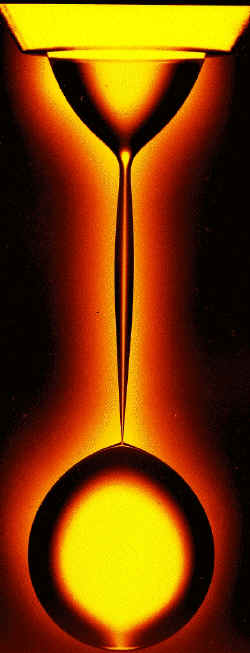Watching the Faucet Drip

When the faucet drips, most people call the plumber or get out their tools, but some physicists are content to study the phenomenon instead. The equations describing the pinch-off of a drop of water are so difficult mathematically that they’ve only recently been solved. The problem is of interest in fields as disparate as black holes and ink jet printers. According to the 9 August PRL, a drop’s break-off point exhibits fractal properties–a slice through it looks the same at any time if you rescale the axes. The authors confirmed that theoretical prediction with their own version of a dripping faucet where drops of one type of fluid drip through a different fluid.
Understanding the way fluid flows break into drops is useful for industry, in such areas as the mixing of chemicals and designing ink-jet printers, but the mathematics goes beyond these direct applications. At the moment of pinch-off, parts of the equations become infinite in a way that appears in other areas of physics, such as fluid turbulence, star formation, and the gravity around black holes. Sidney Nagel of the University of Chicago and his colleagues hope that studying this simple and controllable system will provide insights into these other problems as well.
Nagel and his colleagues have previously observed liquids of different viscosities dripping through air, but in those experiments they could never directly verify one of the most interesting predictions from theory. According to simulations, a snapshot of the pinch-off zone taken at any time during the process should look like one at any other time, except for a rescaling of the axes–a property called self-similarity.
In their latest experiments, the team trained their high-speed video camera on a nozzle dripping glycerin/water mixtures through silicone and other oils. University of Chicago team member Itai Cohen says one motivation for these experiments for him was the beauty of the slowed-down action. “If you’ve ever looked at a lava lamp [fluid] snapping off, it’s just really pretty,” he says. The researchers managed to overlay profiles of the budding drop from three different times within the final 50 ms before pinch-off, confirming the theory. They also developed their own theory of the process based on the experiments, including a description of the dependence of the pinching rate on the viscosities of the two fluids.
Howard Stone of Harvard University says the paper presents “beautiful experimental measurements and theory of the self-similar shape” in the pinch-off zone, as predicted last year by Stone and John Lister, of the University of Cambridge. Stone notes that the data are also in “excellent agreement” in general with simulations by Lister and Wendy Zhang of Harvard–results that follow the University of Chicago work in the current issue of PRL [Phys. Rev. Lett. 83, 1151 (1999)].


